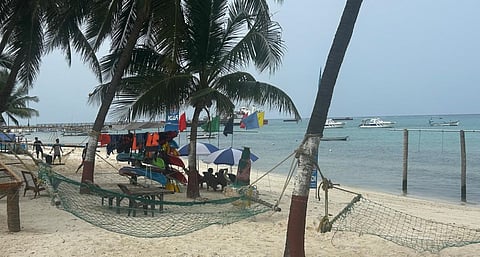

In the first week of September 2025, northern Minicoy island in Lakshadweep woke up to a scene that felt apocalyptic. Black, noxious clouds mushroomed above the horizon, blotting out the turquoise sky and suffocating residents even 200 metres away. The acrid smoke did not come from a passing vessel or an industrial site—Minicoy has none. It rose from their own backyard, where years of accumulated waste had been quietly heaped into a smouldering mountain. When it finally caught fire, the blaze raged for days, filling the air with poison, leaching toxins into lagoons and reefs, and leaving islanders wondering if the paradise they call home is already past saving.
The fire was no accident. It was the inevitable outcome of years of administrative neglect, ad hoc dumping, and a casual willingness to treat the archipelago as disposable. Minicoy’s burning yard resembled, on a smaller but deadlier scale, Kochi’s Brahmapuram blaze of 2023, which blanketed mainland Kerala in toxic smoke. But Minicoy has no hinterland to dilute the impact. Here, waste leaches directly into coral reefs and lagoons, triggering a chain reaction that can obliterate marine life and the livelihoods that sustain island communities.
Spread across 1,500 square metres, Minicoy’s dump yard is a grotesque mix of discarded beds, refrigerators, fishing nets, plastic bags, and e-waste. The story repeats across the Union Territory. From Kiltan to Kalpeni, beaches are lined with mounds of inorganic junk, awaiting the next storm or fire to scatter them across lagoons. According to the Union Territory’s forest and environment department, nearly 4,000 tonnes of dry waste lie uncollected across Lakshadweep—waste that should have been shipped to the mainland years ago but never was.
This crisis is unfolding even as the Union government aggressively rebrands Lakshadweep as India’s answer to the Maldives—complete with pristine beaches, glassy lagoons, and luxury resorts. The contrast is cruel. Behind the glossy brochures lies the stench of burning plastic, the sight of dead coral, and the silence of an administration deaf to its people’s alarms.
“Someone thought burning was the easiest way to get rid of the piles,” says Minicoy resident and activist Fathima Querashia, pointing out that the fire was not accidental but deliberate. “But one spark has had severe ecological consequences.” The damage is visible. At high tide, waste drifts into lagoons, tangling with sea cucumbers, choking fish, and turning clear waters murky. “Now the water has gone grey,” complains a fisherman from Kiltan. “Nets and plastic cling to corals and kill them. There is no system left. We are forced to dump waste on the shore.”
Until 2021, local panchayats ran household-level collection, segregating waste and sending some of it by ship to Kochi or Kozhikode. The system was imperfect, but it functioned. That changed when elected bodies were dismantled and replaced by administration-appointed officers. Residents say waste now rots outside their homes for days. “We drag heavy appliances ourselves to the dump yard. I have an unused freezer at home for years. There’s nowhere to take it,” says one exasperated islander.
Instead of fixing the waste system, the administration has doubled down on tourism-centric projects. Villagers cite the recent construction of a concrete seawall where mangroves could have offered natural protection. “It shows they are not interested in sustainable solutions,” says a resident, requesting anonymity for fear of retaliation. The same disregard surfaced during protests in 2021 and again in 2024, when islanders clashed with officials over unilateral resort plans. Lakshadweep, already in the frontline of climate change, is being pushed into a development model that threatens to erase its ecological foundations.
A 2024 survey by Cochin University of Science and Technology (CUSAT) across 28 beaches and three reef stations on Kavaratti found 32,710 litter items—nearly two-thirds of them plastics. Public littering accounted for 43 per cent. The consequences were grim: 59 per cent of coral colonies smothered by marine litter showed disease and tissue loss; nearly 15 per cent were bleaching. Hazard indices classified the reefs as “highly perilous,” warning of collapse if left unchecked.
“Plastic is entering the food chain. Coral colonies are dying. Awareness campaigns won’t do,” warns S Bijoy Nandan, Dean of Marine Sciences at CUSAT. He calls for AI-backed monitoring, trash booms, and real-time interception before waste hits lagoons. “We need structural measures, not tokenism.”
Already, divers report reefs suffocating under litter densities of two items per square metre. Corals of the Porites genus are particularly vulnerable. Recruitment and growth are faltering. Once reefs die, fish stocks crash, and with them, the livelihoods of islanders who have lived off the sea for centuries.
Marine litter is one of the gravest global threats to oceans. But coral atolls like Lakshadweep are acutely vulnerable. Isolated and with no natural means of absorbing inorganic waste, even small shocks destabilise the system. Meanwhile, Coastal Regulation Zone norms are violated, incinerators remain broken, and the Environment (Protection) Act exists only on paper. Waste is either dumped openly or burned, poisoning land, sea, and air.
The contradiction is glaring. On one hand, official campaigns promise Maldives-style luxury resorts. On the other, local communities fear for survival. “We don’t oppose tourism. But what kind of tourism?” asks an elderly fisherman. “Every year, tonnes of waste wash ashore. Even during the monsoon, we see piles burning, with leachate flowing into lagoons. How will our children fish in poisoned waters?”
The administration admits to logistical hurdles: waste can be transported only four or five months a year; monsoon closes sea routes; private operators refuse to carry garbage or demand exorbitant fares; and government barges prioritise food and fuel. Officials now talk of chartered vessels and Requests for Proposals. But residents and scientists fear it is already too late. The 26 uninhabited islands, equally battered by marine litter, remain wholly unattended.
For now, piles grow higher, fires break out, and reefs inch closer to collapse. The National Green Tribunal has begun monitoring, but governance inertia persists. As officials debate contracts, polyps die silently in lagoons.